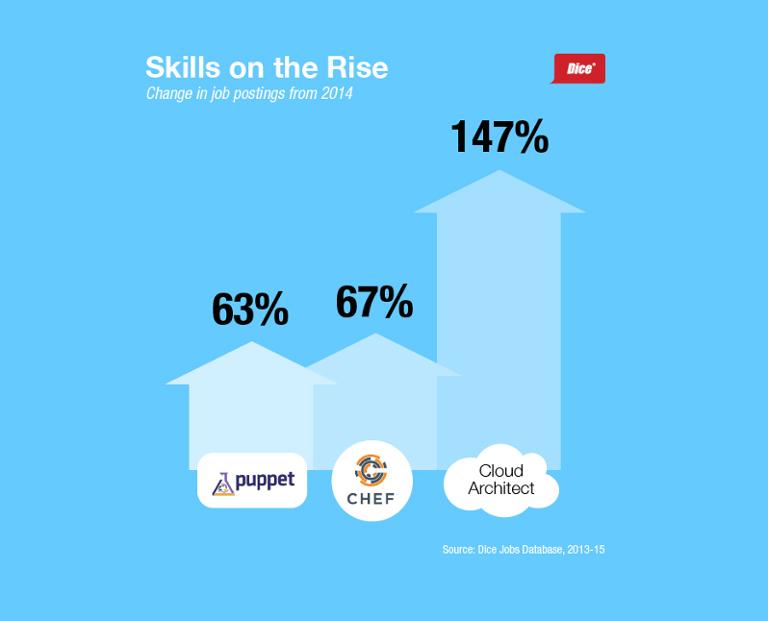
 More companies are shifting from on-premises data centers and servers to cloud-based services, creating added demand for system administrators and “cloud architects” who can effectively deploy and maintain next-generation architecture. Tech pros want this deployment and maintenance of backend infrastructure to behave with the flexibility of software development, with consistent and repeatable processes (as well as a lot of automation to make the job easier). That desire has sparked the rise of configuration-management tools such as Puppet, Chef, Ansible and SaltStack, along with increasing demand for professionals who can effectively manage them. On Dice.com, for example, the number of job postings for Puppet professionals increased 63 percent between May 2014 and May 2015. This rise in demand has also translated into higher earnings, with the average salary for Puppet professionals rising to $172,083, representing a year-over-year increase of 8 percent from the same period last year. Chef’s rise in demand has paralleled that of Puppet. In May 2015, the average annual income for tech professionals skilled in Chef was $168,750, according to the Dice Salary Survey, a 6 percent increase year-over-year. The number of job postings for Chef professionals climbed 67 percent between May 2014 and May 2015. Demand for Puppet and Chef has grown as more system administrators and cloud architects have taken an interest in virtualization and cloud technologies that allow them to provision servers on demand. Both tools, which are mainly Ruby-driven development processes, can define what a newly provisioned server should do, whether configuring systems or deploying software, without the need for human intervention. Getting the most use out of any of these tools, however, hinges on integrating infrastructure maintenance into the internal processes and DevOps culture of the company. That’s why system administrators and cloud architects need the soft skills to effectively communicate with others within their respective firms. “Like many other up-and-coming tech skills, companies really need to be aggressive, not only with their recruitment strategies but also with their employment offers,” said Shravan Goli, president of Dice. “In a tech market with an unemployment rate of 1.5 percent, it is difficult to find qualified, available tech talent because there is a shortage of supply.” The best way to lure talent, as always, is through generous compensation packages and perks; many tech pros also gravitate toward companies that offer a broader sense of mission, such as making all the world’s information accessible and useful. Over the next several quarters, as companies embrace new concepts of infrastructure, they’ll need more technology pros with the ability to build, monitor and adjust systems. Those who learn the latest tools could find themselves more highly sought-after by employers.
More companies are shifting from on-premises data centers and servers to cloud-based services, creating added demand for system administrators and “cloud architects” who can effectively deploy and maintain next-generation architecture. Tech pros want this deployment and maintenance of backend infrastructure to behave with the flexibility of software development, with consistent and repeatable processes (as well as a lot of automation to make the job easier). That desire has sparked the rise of configuration-management tools such as Puppet, Chef, Ansible and SaltStack, along with increasing demand for professionals who can effectively manage them. On Dice.com, for example, the number of job postings for Puppet professionals increased 63 percent between May 2014 and May 2015. This rise in demand has also translated into higher earnings, with the average salary for Puppet professionals rising to $172,083, representing a year-over-year increase of 8 percent from the same period last year. Chef’s rise in demand has paralleled that of Puppet. In May 2015, the average annual income for tech professionals skilled in Chef was $168,750, according to the Dice Salary Survey, a 6 percent increase year-over-year. The number of job postings for Chef professionals climbed 67 percent between May 2014 and May 2015. Demand for Puppet and Chef has grown as more system administrators and cloud architects have taken an interest in virtualization and cloud technologies that allow them to provision servers on demand. Both tools, which are mainly Ruby-driven development processes, can define what a newly provisioned server should do, whether configuring systems or deploying software, without the need for human intervention. Getting the most use out of any of these tools, however, hinges on integrating infrastructure maintenance into the internal processes and DevOps culture of the company. That’s why system administrators and cloud architects need the soft skills to effectively communicate with others within their respective firms. “Like many other up-and-coming tech skills, companies really need to be aggressive, not only with their recruitment strategies but also with their employment offers,” said Shravan Goli, president of Dice. “In a tech market with an unemployment rate of 1.5 percent, it is difficult to find qualified, available tech talent because there is a shortage of supply.” The best way to lure talent, as always, is through generous compensation packages and perks; many tech pros also gravitate toward companies that offer a broader sense of mission, such as making all the world’s information accessible and useful. Over the next several quarters, as companies embrace new concepts of infrastructure, they’ll need more technology pros with the ability to build, monitor and adjust systems. Those who learn the latest tools could find themselves more highly sought-after by employers.


